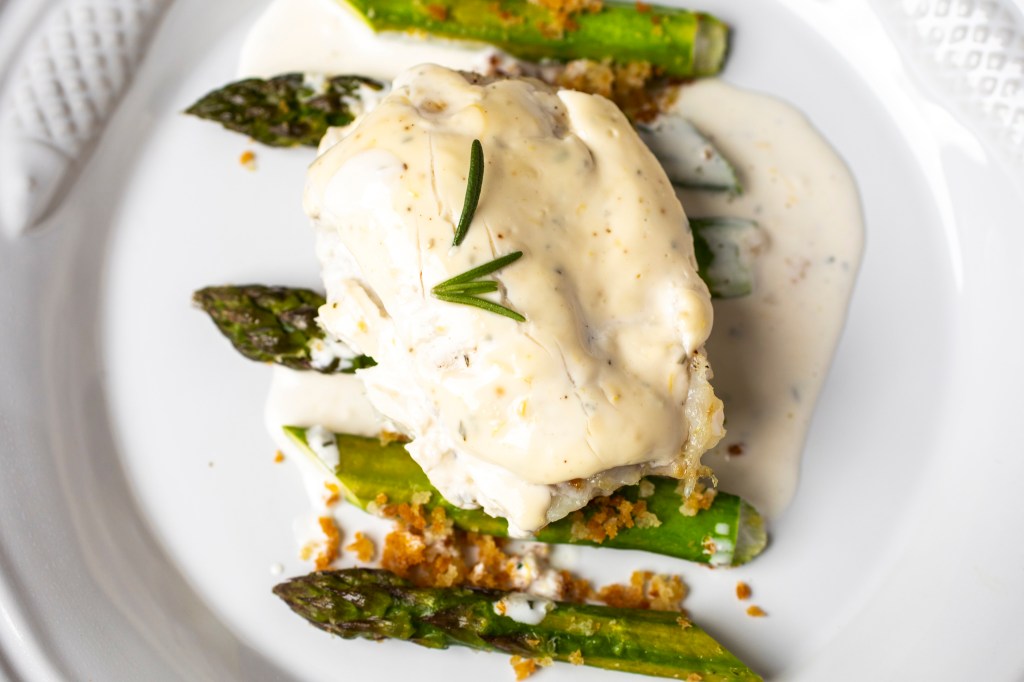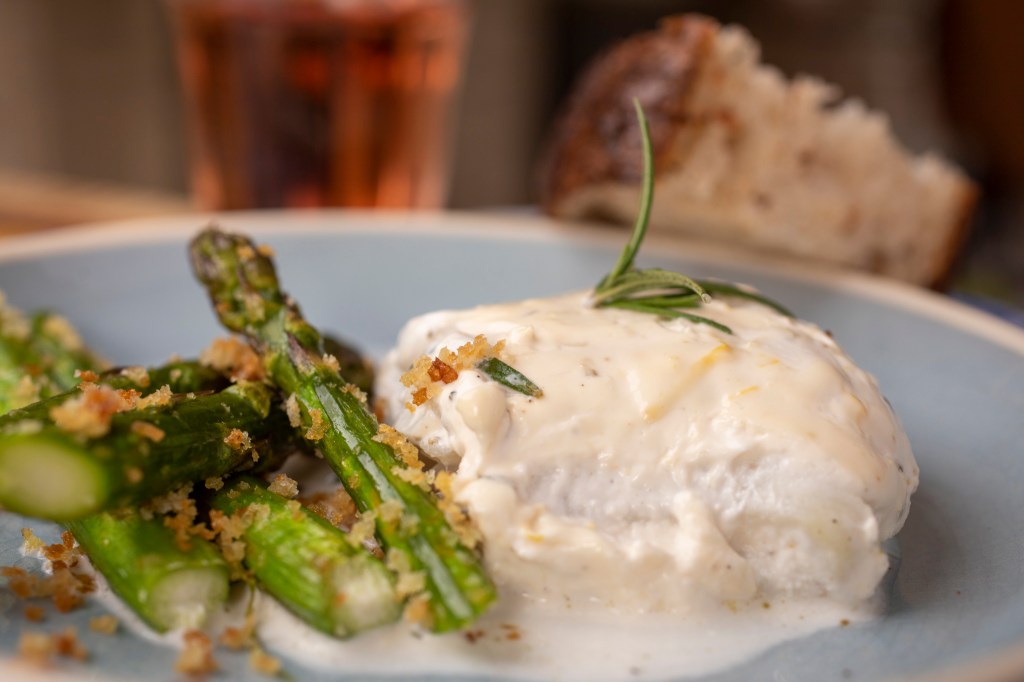
Salt and pepper scrod, smear on the yogurt-mayo combo and throw it in the oven. Wait a bit, then add a pound of asparagus (two pounds works too), just so you don’t have a meal that’s white fish on white plate with white sauce. Ten minutes of prep, half an hour while everything cooks – wango-tango and Bob’s your uncle – there’s dinner. We didn’t bother adding a starch because we had a loaf of sourdough bread at hand.
This is the second of three simple fish recipes that Jody and I put on The Garum Factory to-do list in order to entice people to cook more fish at home, particularly in light of the empty meat and poultry shelves in many markets these days. I can also confirm, that while I’m not a fan of leftover fish, this was great in a salad the next day. Think about it – the leftovers are cold seafood in a sauce based on mayonnaise.
We cooked this recipe twice – the trial run and then the actual photo shoot. We unknowingly purchased previously frozen scrod the second time around and there was a dramatic difference in the amount of juice the fish released as it baked (way more with the frozen), which changed our thinking a bit. If this happens to you, just pour off the extra fish juice until you have about a half cup lingering in the bottom of the pan, then pick up the recipe when it says to mix in the leftover yogurt-mayo with fish juice to make a sauce. Cooking time is the same. No judgement on fresh versus frozen. In spite of our own preferences we were surprised at how good it was, and I gobbled up leftovers.
If you’re not from New England, then the term “scrod” may be unfamiliar. Every newcomer to Boston eventually runs into the local straightman who announces, “I got scrod last night.” To which his partner wag says, “Funny, I’ve never heard the past participle used in conversation.” [Insert rimshot.]
Originally “scrod” meant any small whitefish – typically haddock or cod – that was split down the middle and broiled or baked. Today it refers to the smallest category of fillet of any whitefish – cod, haddock, pollock, hake – but whenever we see fish labeled scrod it’s almost always haddock or cod, with hake and pollock appearing under their own names, and larger cod or haddock labeled as themselves. We used haddock scrod for this recipe. Enjoy.
Ken

Baked Scrod with Yogo-Mayo
Ingredients:
- 1½ pounds haddock or cod scrod
- Kosher salt and freshly ground black pepper
- 1 pound asparagus
- ½ cup mayonnaise—we use Hellman’s
- ½ cup Greek yogurt
- 8-10 shakes of Worcestershire sauce
- Zest and juice of 1 lemon
- 1 teaspoon chopped fresh rosemary + additional sprigs for garnish
- 1 clove garlic, grated on a microplane
- 3 tablespoons extra virgin olive oil
- 2 tablespoons bread crumbs
Instructions:
- Season the fish with salt and pepper. Let set in the fridge for 30 minutes.
- Snap the asparagus stems to remove the tough ends. If the stems are thick, peel them. Soak the asparagus in water to remove any dirt at the tips. Drain.
- Mix the mayonnaise, yogurt, Worcestershire Sauce, the zest of the lemon and half the juice of the lemon, chopped rosemary and grated garlic in a bowl. Season with salt and pepper.
- Preheat the oven to 350 degrees F.
- Brush a baking dish with oil and set the fish on top. Spread the yogurt mayonnaise over the fish, reserving a few tablespoons for the sauce later.
- Bake in the center of the oven until done, about 25 minutes, depending on the thickness of the fish. If juices accumulate in the pan, it’s fine.
- Halfway through the baking, put the asparagus on a baking sheet, drizzle with the remaining olive oil and season with salt and pepper. Roll them around to coat evenly.
- Bake with the fish for 5 minutes. Remove the asparagus from the oven, sprinkle with the crumbs, roll around so the crumbs get coated with oil. Bake until the asparagus are tender and the crumbs are golden brown, about 5 minutes more. Just before serving, squeeze the remaining lemon juice over the asparagus. Don’t do it too soon or the crumbs will get soggy.
- Combine the reserved yogurt-mayonnaise with ½ cup of warm fish juices to make a sauce.
- Serve the fish with the asparagus and the additional sauce.










Jody Notes
My Dad was a mayonnaise guy, mostly store-bought, but twice a year he made it himself – oil, egg and whisk – which he called “Adams mayonnaise.” Adams mayonnaise only appeared in coleslaw at Thanksgiving and as an accompaniment for tomato-clam aspic at Christmas. He made it with tarragon vinegar and it was deliciously over-salted.
I remember my father taking on dinner responsibilities in the period after he retired when my mother was still working. Simple meals, unlike the M.F.K. Fisher and Elizabeth David creations my mother made on weekends. This is his recipe – I have no idea where he got it. My father was a rare book librarian and it’s fun to speculate that at his monthly lunch at the Club of Odd Volumes in Boston he and his fellow bow-tied antiquarians were hotly swapping fish recipes instead of book gossip.
We were a Hellman’s family, not a Miracle Whip family, and it’s possible he found the recipe on the label of a Hellman’s jar. Regular yogurt almost certainly featured in the version he made – Greek yogurt didn’t hit the American kitchen table in a big way until after he was gone. If you’re up for it, homemade mayonnaise might take this dish up a notch, but it’s pretty damn good already. But this is an it-is-what-is recipe, with my father’s culinary fingerprints all over it, including the Worcestershire sauce (English garum!), which comports with our family living in England at different times in my childhood – once in London, another time in Oxford. It’s simple and yummy. If there are leftovers, you have an instant fish salad. Break up the fish a bit, add some sliced scallions, chopped celery, herbs and serve it the way he would have. . . on toast.
The recipe in today’s post is a handshake with memory. Worcestershire sauce and lemon juice are my father; according to my mother he also added chives, probably dried ones. (Oops! We lost the dried chives.) The lemon zest, garlic and rosemary are me. Thanks, Dad.

As always, great stories, delicious recipes, beautiful photos (and nice form on the oven squat Ms. Adams) xox
Hahaha! (I’m her personal trainer.) Ken
Great! But your Dad called it “Spiller” mayonnaise – a recipe handed down from his maternal grandmother. And I think he’d gladly try your updated version of his scrod recipe.
I’ll bring this to your daughter’s attention. :) Ken
Beautiful to look at too, not just delicious ! All past, present and future participles would agree with me, ha ha!
Hahaha! Glad you enjoyed it. I can’t believe I ate it as leftovers – that’s a personal best for me. Ken
I had to look up “scrod”. Over this side of the pond, we would probably call it pollack or perhaps haddock. I had to laugh when you tried to justify your current baking obsession with the “We didn’t bother adding a starch….”. Lovely as always.
Pingback: Baked Scrod with Yogurt Mayonnaise — The Garum Factory | My Meals are on Wheels